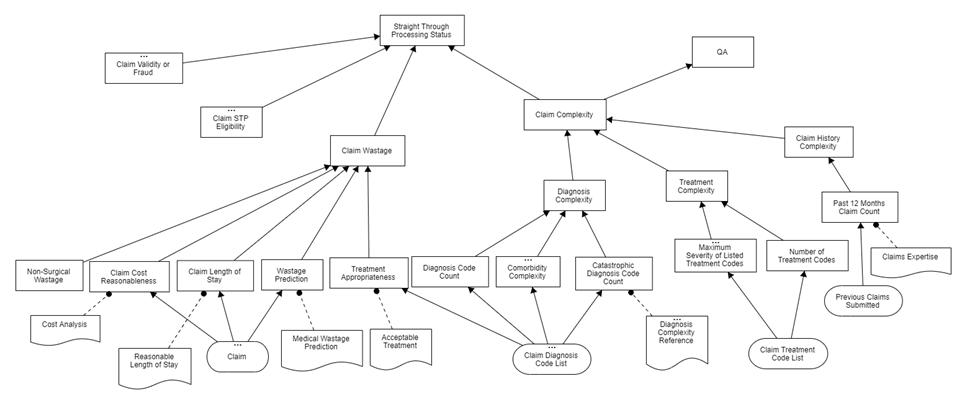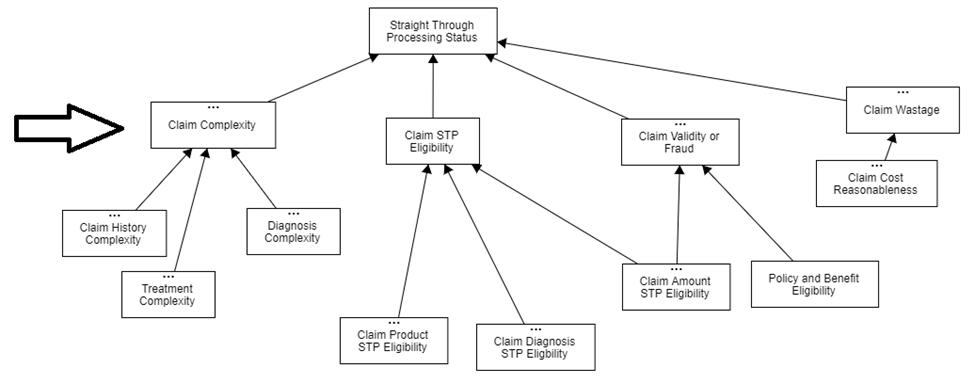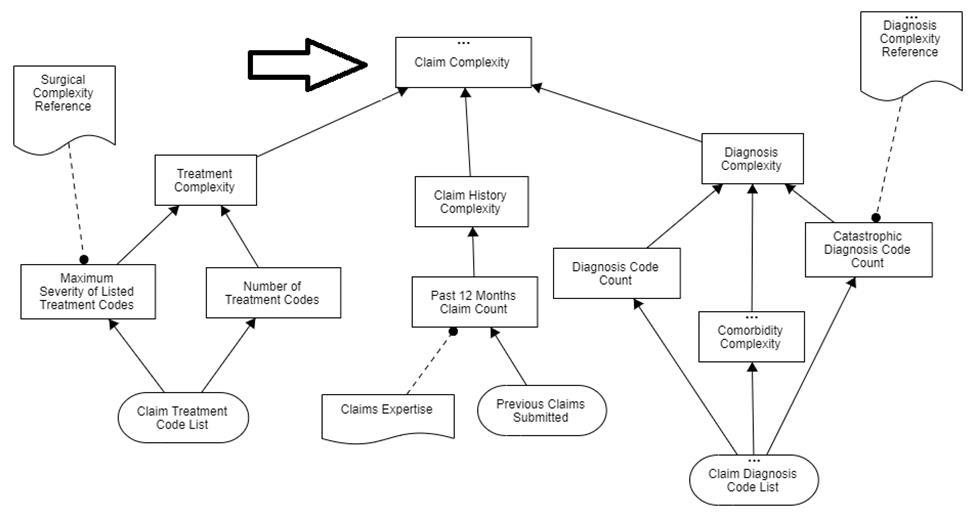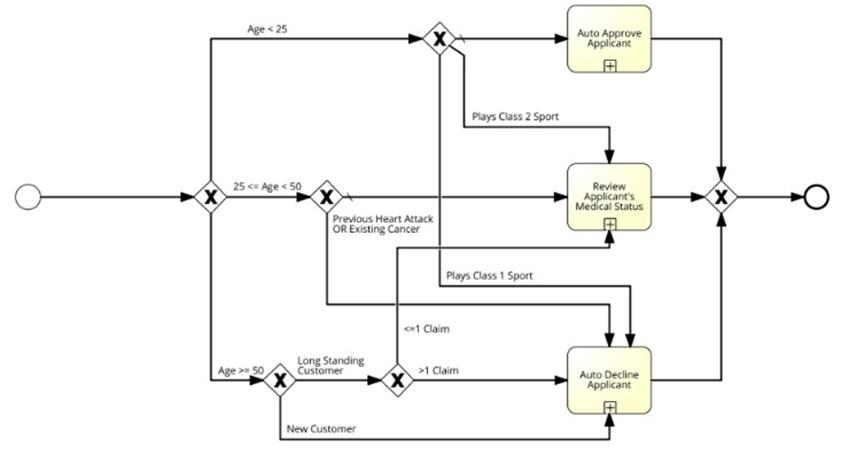
18 minute read
Decision Modeling
Decision Modeling
By James Taylor
by James Taylor, Decision Management Solutions
Email: james@decisionmanagementsolutions.com
Copyright © 2022 Decision Management Solutions. All rights reserved.
Introduction
Organizations make many different kinds of decisions. They make strategic, one-off decisions about direction or intent. They make tactical decisions with broad impact about products and about how to run the business. And they make day-to-day operational decisions about specific customers, transactions or interactions. While some decisions are open-ended, with an infinite continuum of possible options, most decision-making is about using the data available at the moment to pick an option from a set of defined (or at least definable) options. Some of these decisions are made once and only once. But many, especially the more structured ones, must be made over and over with new data each time. Ideally, an organization would always apply the best possible decision-making approach to the data every time. In practice, the decisionmaking approach probably changes each time. Each of the people making the decision likely has their own way of making the decision. Plus, people struggle to be consistent and use the same decisionmaking approach reliably. This creates inconsistency or noise in the system and means the decision is not made accurately and consistently each time. Decision modeling focuses on the repeatable, operational decisions made every day by organizations. Decision modeling creates a visual blueprint of the decision-making approach you’re going to use. It shows everyone how the decision should be made. It creates a shared understanding of the best, most legal and most appropriate approach available. Decision modeling also decomposes the decision into its component parts, breaking down a complex decision into a network of simpler decisions, such that the results of simpler decisions are combined to enable the more complex decision to be made. Decision modeling lets you capture how a decision will be made before you make it, so you can get everyone on the same page, decide consistently, ensure best practice, and apply data-driven analytics effectively. Various approaches to building decision models are available, but the best and most widely used is the Decision Model and Notation standard from the Object Management Group or OMG. The OMG is a standards development organization dedicated to bringing together its international membership of end-users, vendors, government agencies, universities and research institutions to develop and revise technology standards as technologies change throughout the years.
The Decision Model and Notation Standard
About ten years ago, the OMG requested submissions for a standard to address the ad hoc nature of the specification of decision-making logic for process and system designs. The intent was to develop a technology-agnostic and standardized way to model decisions. In particular, the standard was expected to make decision models communicable among people and machines and to support both decision automation (digital decisioning or decision management as it is often called) and decision support scenarios. The standard was to focus primarily on capturing the logic, the business rules, of a decision, but was to be open to other decision-making approaches such as predictive analytics or constraint-based optimization models. Companies including Decision Management Solutions, IBM,
Oracle, FICO and Tibco responded with proposals. The first version of the Decision Model and Notation (DMN) standard [1] was published in 2015, since then it has been regularly updated – v 1.4 has just been approved and will soon be published.
The Elements of DMN
DMN has three perspectives that combine to create a complete decision model. • A decision requirements model defined using a series of decision requirements diagrams, that shows how decisions are decomposed into their component pieces, the data each piece requires and where the knowledge for making a decision comes from. • A set of decision logic definitions, mostly decision tables, that define how each decision in the decision requirements model can be made. • A set of business context relationships that tie decisions into organizations, processes and Key
Process Indicator (KPI)/measurement frameworks.
A DMN Example
The example below shows these various perspectives.

Figure 1: A decision requirements model
Figure 1 shows how an insurance company might decide how to pay a claim while Figures 2a and 2b shows the same decision model using several simpler views. The more complex decision requirements diagram shows all the sub-decisions that make up the wastage and complexity parts of the claims handling decision. The two simpler diagrams are views that show only part of the model – a high level decision summary and the sub-decisions of the decision about claim complexity. Support for views is a key element of DMN, making it usable for even the most complex decision-making problems.

Figure 2a: Summary decisions-only view of the same decision requirements model
Using the diagrams in Figures 2a and 2b, we can see that to decide on the Straight Through Processing Status of a claim, we must decide how complex the claim is (Claim Complexity), if it is eligible for straight through processing (Claim STP Eligibility), if there are fraud or validity concerns (Claim Validity or Fraud) and if there are any concerns about wastage (Claim Wastage). Only after these four sub-decisions have been made can we decide how to process the claim. Behind the model is a set of definitions of these decisions, specifically the questions that must be answered in each case and the possible answers. For instance, the Straight Through Processing Status decision assigns a status to each claim – Auto Approve, Auto Decline, Review or Investigate. If we know the answers to the four sub-decisions, then we can determine the right option from this set. The Claim Complexity decision is also shown in the second diagram view – it is the same decision in both diagrams. This view shows how Claim Complexity requires an assessment of Treatment Complexity, Claim History Complexity and Diagnosis Complexity. Each of these decisions is similarly broken down into its component sub-decisions.

These diagrams also show the Input Data (shown as ovals) such as Previous Claims Submitted and the Claim itself as well as Knowledge Sources that can be referenced to understand how a particular decision should be made such as the Surgical Complexity Reference. Input Data are data structures with individual fields or items and the Knowledge Sources are typically documents or regulations.

Figure 3: A decision table
Figure 3 shows a decision table containing the logic for the Claim Complexity decision. Decision tables like this one build on the requirements model to show exactly how the various sub-decisions and data elements combine to select options. Each row can be considered a single rule and the columns are all ANDed together – ORs result in additional rows. So, for instance, if the Diagnosis Complexity is Low and the Claim History Complexity is Low and the Treatment Complexity is Low then the Claim Complexity is also Low. The columns correspond to the requirements shown on the diagram – in this case each represents a sub-decision though they can also represent pieces of Input Data. Figure 4 shows how some of the decisions in the model impact various metrics. The decisions in the table are the main sub-decisions and while all of them impact the Straight Through Processing rate, likely a key metric, some have side effects that must be considered. For instance, loosening the fraud checks will increase the rate of straight through processing but only at the expense of increased fraud.

Figure 4: A decision to KPI/Organization grid
Key Principles of DMN
In an introductory article like this one, only the briefest summary of the approach can be provided; however, additional sources abound. [2], [3], [4], [5], [6] Several key principles underlie the decision modeling approach enabled by DMN. First and foremost, DMN manages complexity. It allows you to break a decision-making problem down into pieces that are orchestrated into a complete solution. This simplifies the problem, creates a visual blueprint, and allows the logic to be written for each piece, keeping it simpler and easier to manage –thus avoiding many of the pitfalls of more traditional rules-based approaches. For instance, a complex decision about auto-approving auto loans involved more than 100 sub-decisions but no complex rules.
Second, this approach lends itself to business ownership of the model and a business-focused creation process. Technical teams can create a decision model and a decision model can be reverseengineered from existing logic and built bottom-up, but the top-down decomposition allows for a business-led project. Business experts can describe how they would break down a decision-making problem and this leads naturally to a decision model that matches the way they think. This makes the model a better fit for reality and helps ensures business engagement in the ongoing management of the model. For instance, one insurance claims team uses the decision model as part of weekly updates to their claims handling system. Thirdly, DMN scales to extremely complex problems. Decision requirements diagrams are views on an underlying model or graph. This allows multiple diagrams to be built for the same problem, showing different perspectives or layers of detail. Even when a decision might involve hundreds of subdecisions, there is no requirement to show them on a single diagram. Tooling that implements this approach allows teams to easily manage large, complex models while still presenting consumable, easily verifiable views to business experts. For instance, in both the claims and auto loan approval decisions, a dozen or so diagrams were created so that each was focused, clear and usable. Finally, the approach is remarkably flexible. A focus on automation is not required - decision models are useful even when the decisions are manual. The same notation and approach can be used to document manual decision-making, to design decision support tools and to automate all or part of a decision. This allows decision models to be built as part of determining the appropriate level of automation. The notation also does not require that you write declarative logic for a decision in the model. This is the most common approach, but decisions can be defined as being automated using constraint-based optimization, predictive analytics, or machine learning models also. For instance, a decision to specify a custom manufacturing design involved a model that included manual decisions on the viability of some options, rules-based decisions on where parts could fit, an optimization model to identify a set of plausible layouts, a predictive analytic to predict maintainability of each such layout, and a set of rules to use all this information to pick the best design. All coordinated in a single decision model.
Decisions and Business Processes: BPMN and DMN
Many people first come across DMN because they are familiar with the Business Process Model and Notation or BPMN [7] . The two standards are highly complementary. Experience is that decision models are often used standalone, but they can also be used very effectively alongside BPMN models. In Figure 5a, for instance, a BPMN process model shows how to determine the next task for an applicant for medical insurance. It determines if the next task is to automatically approve them, automatically reject them or arrange for them to have a medical examination. Despite only simple logic being added to this process model, it is already complex.

Figure 5a: Process model
When a DMN decision model is added, as shown on in Figure 5b, the process becomes much clearer. A decision must be made as to the riskiness of the applicant and, based on that, the appropriate task can be executed. The logic of the decision is then represented by a decision requirements diagram and a decision table. The set of diagrams contains the same information, but the use of both DMN and BPMN separates concerns and simplifies the problem.

Figure 5b: Process model with a decision model
When both approaches are used at the same time it is important to treat them as independent, complementary models. If compromises are made regarding what goes in the decision model and what goes in the process model, then value will be destroyed not added. BPMN users who add proper DMN models to their approach see three main benefits – their processes are simpler, smarter and more agile.
Simpler: Embedding decision-making in a process makes it complex. Layers of gateways being used to represent logic or complex conditions associated with those gateways makes processes hard to read and overly complex. Removing all this logic from the process and instead representing it as a decision model greatly reduces the complexity of the process. A Business Rules Task can be linked to the Decision being made or, at implementation time, a Decision Service can be defined to show the decision logic being automated and this service can be called from the process. Smarter: Many processes rely on complex calculations being made as they are executed. It is extremely difficult to show the logic of such calculations in a process model. Defining a decision model for these calculations is a perfect solution. Similarly, it is often difficult to identify how to apply artificial intelligence (AI) and machine learning (ML) to a process to make it smarter. Identifying the decisions in the process, and modeling those decisions, clearly identifies the possible ML and AI pressure points (they will all be decision-making ones) and so makes it possible to effectively apply these powerful technologies. More Agile: Externalizing decision-making in a decision model makes it much easier to change the behavior of a process. This is partly thanks to the simplification of the process that modeling decisions produces, but mostly it comes from the separation of concerns. Experience shows that decisionmaking changes much more often than process, as court rulings, policy changes or the behavior of competitors directly impact it. Embedding decision-making in a process requires that the process change each time. Separating it out allows the decision model to be changed while keeping a stable process.
Lessons Learned Applying DMN
The team at Decision Management Solutions has modeled more than 5,000 decisions across more than 70 projects for 40 customers over the years. We have used the resulting decision models to drive automated decisions, train people to make decisions manually, design decision support environments, orchestrate multiple decisioning technologies and document official decision-making approaches. We have learned many lessons but three show up again and again. The first and most important is to apply Decisions-First Design Thinking. The principles of design thinking – user-centricity, empathy, collaboration, ideation, experimentation and iteration – are a great fit for decision modeling. Applying these principles while building a top-down, business-led decision model results in the highest quality models and the most engagement. Wherever possible, build decision models top-down working directly with the business. Use the model to capture how people really make the decision today, including all the things that make it difficult. And use this model to discuss new ideas, try out new approaches and iterate toward a successful outcome. Second, recognize that decision-making involves many kinds of technology. While “AI” is all the rage, this is an overused and often vaguely applied term. Making a machine artificially intelligent is almost always about enabling it to make decisions the way that a human would – or better. This might include documenting explicit logic – business rules – to capture how a regulation must be applied, using machine learning or other analytic models to capture what historical data says will work, or using constraint-based optimization to pick between viable options. A decision model provides an ideal framework for mixing and matching these technologies and delivering a successful outcome. Finally, think always about continuous improvement. Decision-making is not static. Regulations change, competitors adapt, markets move, and people change their minds. Building decision models and implementing decisioning systems based on those models requires that this change be allowed for. Capturing data about how decisions were made and the business outcomes of each decision is critical. A regular update cycle is essential too – outcome data must be reviewed, new and changed policies and regulations assessed and the decision-making improved.
How DMN drives AI Adoption
Given the investments being made in AI today, it’s worth considering the role of decision modeling and DMN in realizing the potential of AI-enabled systems and products. After all, study after study shows a high rate of failure in AI projects and many “successful” ones remain in limited or pilot deployment [8], [9], [10] Broad, deep use of AI to solve real business problems remains the exception not the rule. A better approach is possible. The broad definition of AI introduced above – any technology that can be used to make a machine decide like a human – is an important first step. Once we recognize that AI is not just deep learning and neural networks our odds of success start to rise. Successful AI efforts combined explicit decisionmaking logic with analytical techniques based on historical data and mathematical models of reality to make decisions.
To apply these technologies effectively, though, we need to know when to use each of them and how to orchestrate them into a solution. A decision model meets both of these needs. By breaking the problem down into many sub-decisions, it becomes clear which technology will work where: This decision is constrained by regulations, so rules will be required. This one involves a tradeoff between options, so perhaps optimization will work better. A third might need to be based on patterns that have shown up historically. Because a decision model is a clear, visual blueprint that can be understood by everyone, starting with one means that the discussion is focused on the business problem to be solved by AI not on AI technology. It applies everyone’s expertise – business experts, data experts, mathematicians, programmers – maximizing the chance of success. A decision model allows for incremental delivery, perhaps starting with those elements that require the least new technology or that don’t require lots of high-quality data. As the solution evolves, new technology and better data can be applied to improve the quality of decisions being made. Value can be created sooner and technology risks can be mitigated. For many decisions, decision models offer one last advantage: They allow the role of human decisionmakers to be clearly articulated. It’s often impractical for a human to review an automated decision in the time available, so making the decision a “recommendation” and asking a human to press the button is just pretending to have a human engaged. A decision model allows for those elements of the decision that should be made by a human to be made by a human and then integrated into an overall decision. Sometimes this means the human makes the final call, but more often it means the human provides a critical piece of judgment or expertise that will ensure that the automated decision is the right one.
What’s Next
The DMN standard continues to evolve, with the committee making small incremental improvements as more experience is gained with implementations and use cases around the world. More importantly, adoption is growing with more companies standardizing on decision modeling as a key requirements and design approach for their decision-making systems. This adoption is being supported by new organizations such as DecisionAutomation.Org, dedicated to helping companies adopt and succeed with decision modeling. Both alongside process models and independently, decision models are showing their value in traditional rules-based systems and more complex machine learning and AI-based environments.
References
[1] Decision Model and Notation, version 1.3, Object Management Group, March, 2021. [2] James Taylor and Jan Purchase, Real-World Decision Modeling with DMN, Meghan-Kiffer Press, 2016. [3] James Taylor, Digital Decisioning: Using Decision Management to Deliver Business Impact from AI,
Meghan-Kiffer Press, 2019. [4] Bruce Silver, DMN Method and Style , 2nd edition, Cody-Cassiday Press, 2011. [5] Decision Modeling with DMN (White Paper), Decision Management Solutions, March, 2020. [6] Why Decisions Matter (Executive Brief), Decision Management Solutions, June, 2020. [7] Business Process Model and Notation, version 2.0.2, Object Management Group, January, 2014. [8] Ari Jouri, Why 90 percent of all machine learning models never make it into production, Toward
Data Science (blog), November, 2020. [9] Randy Bean, Why Is It So Hard to Become a Data-Driven Company?, Harvard Business Review,
February, 2021. [10] Andrew White, Our Top data and Analytics Predictions for 2019, Gartner Blog Network, January, 2019.
About the Author
James Taylor is the CEO of Decision Management Solutions and a leading expert in digital decisioning and using advanced analytics, business rules and AI to improve business results. He provides strategic consulting to companies in the Fortune 100 and top 100 companies globally, working with clients in all sectors to adopt decision-making technology. James is a faculty member of the International Institute for Analytics (IIA), an IBM Champion and is the author of numerous books including “Digital Decisioning: Using Decision Management to Deliver Business Impact from AI” (MK Press, 2019) and “Real-World Decision Modeling with DMN” (2016, Meghan-Kiffer) with Jan Purchase. He writes a regular blog at JT on EDM, contributes to standards and delivers webinars, workshops and training. He is a regular keynote speaker at conferences around the world. James was previously a Vice President at FICO where he developed and refined the concept of Decision Management. The best-known proponent of the approach, James helped create the emerging Decision Management market and is a passionate advocate of decision management. He understands how companies buy and use these technologies, and he has helped companies successfully adopt these technologies and apply them in the context of Business Process Management and Business Intelligence initiatives.





